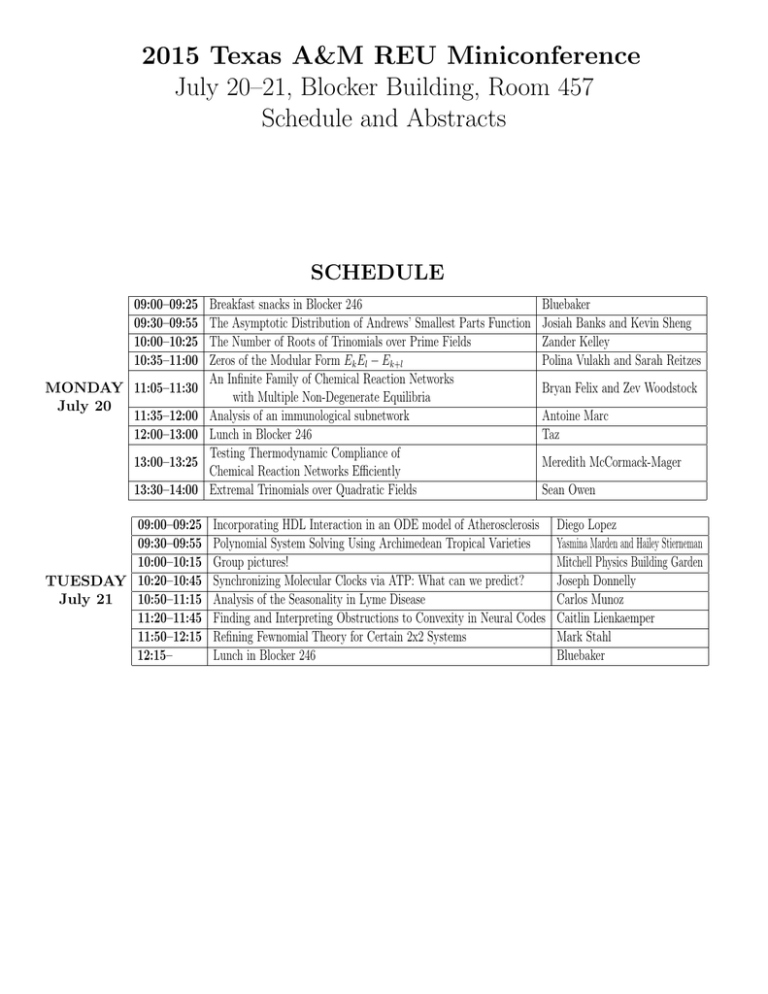2015 Texas A&M REU Miniconference July 20–21, Blocker Building, Room 457 SCHEDULE
advertisement

2015 Texas A&M REU Miniconference
July 20–21, Blocker Building, Room 457
Schedule and Abstracts
SCHEDULE
09:00–09:25
09:30–09:55
10:00–10:25
10:35–11:00
MONDAY 11:05–11:30
July 20
11:35–12:00
12:00–13:00
13:00–13:25
13:30–14:00
09:00–09:25
09:30–09:55
10:00–10:15
TUESDAY 10:20–10:45
July 21
10:50–11:15
11:20–11:45
11:50–12:15
12:15–
Breakfast snacks in Blocker 246
The Asymptotic Distribution of Andrews’ Smallest Parts Function
The Number of Roots of Trinomials over Prime Fields
Zeros of the Modular Form Ek El − Ek+l
An Infinite Family of Chemical Reaction Networks
with Multiple Non-Degenerate Equilibria
Analysis of an immunological subnetwork
Lunch in Blocker 246
Testing Thermodynamic Compliance of
Chemical Reaction Networks Efficiently
Extremal Trinomials over Quadratic Fields
Bluebaker
Josiah Banks and Kevin Sheng
Zander Kelley
Polina Vulakh and Sarah Reitzes
Bryan Felix and Zev Woodstock
Antoine Marc
Taz
Meredith McCormack-Mager
Sean Owen
Incorporating HDL Interaction in an ODE model of Atherosclerosis
Polynomial System Solving Using Archimedean Tropical Varieties
Group pictures!
Synchronizing Molecular Clocks via ATP: What can we predict?
Analysis of the Seasonality in Lyme Disease
Finding and Interpreting Obstructions to Convexity in Neural Codes
Refining Fewnomial Theory for Certain 2x2 Systems
Lunch in Blocker 246
Diego Lopez
Yasmina Marden and Hailey Stierneman
Mitchell Physics Building Garden
Joseph Donnelly
Carlos Munoz
Caitlin Lienkaemper
Mark Stahl
Bluebaker
ABSTRACTS
(In order of appearance)
The Asymptotic Distribution of Andrews’ Smallest Parts Function
by Josiah Banks and Kevin Sheng
We present an asymptotic formula for Andrews’ smallest parts function, which counts the number of
smallest parts associated to partitions of a positive integer. An important role is played by the distribution
of certain points in the complex upper half-plane called Heegner points; they are roots of binary quadratic
forms of a given negative discriminant.
The Number of Roots of Trinomials over Prime Fields
by Alexander Kelley
Let #Z(f ) denote the cardinality of the zero-set of a polynomial f over a finite field Fq with q a prime
power. In their recent work, Cheng, Gao, Rojas, and Wan establish an upper bound for #Z(f ) when f is
a sparse polynomial. However, they observe that in the case of trinomials over Fp (with p a prime), their
√
bound (O( p)) appears to be far from optimal. We present computational data that suggests that the
number of roots of trinomials may grow as slowly as O(log p). Additionally, we investigate “typical” values
for #Z(f ). In particular, we conjecture that #Z(f ) is Poisson-distributed when Fp and deg(f ) are fixed
and the coefficients of f vary. Finally, we prove a weaker version of this statement under the Generalized
Riemann Hypothesis.
Zeros of the Modular Form Ek El − Ek+l
by Sarah Reitzes and Polina Vulakh
PP
The Eisenstein series of weight k is a modular form defined by Ek (z) = 21
(cz + d)−k , where the sum
is taken over all relatively prime integers c and d. We focus on the behavior of the Eisenstein serires in
the intersection of the strip − 21 ≤ x ≤ 21 with the region |z| ≥ 1, called the fundamental domain. Rankin
and Swinnerton-Dyer proved that all of the zeros of the Eisenstein series in the fundamental domain lie
on the arc |z| = 1. In this study we consider the zeros of the weight k + l modular form Ek El − Ek+l
in the fundamental domain. Based on numerical evidence, we conjecture that all of its zeros lie on the
boundary. In the extreme case where l = 4, we conjecture that all of the zeros lie on the arc |z| = 1, while
at the opposite extreme where k = l, we conjecture that all of the zeros lie on the lines x = ± 21 . Using
asymptotoic approximations, we have proved that for l ∈ {4, 6, 8} all of the zeros lie on the arc |z| = 1 and
that for k = l, almost all of the zeros lie on the lines x = ± 21 .
An Infinite Family of Chemical Reaction Networks with Multiple Non-Degenerate Equilibria
by Bryan Felix and Zev Woodstock
Multistationary chemical networks are a subject of interest to scientists and mathematicians alike. While
some criteria for multistationarity have been given, explicitly solving for these rates and steady-state
concentrations is nontrivial. Nonetheless, for a specific family of systems K(m,n), we describe in this talk
how to give closed forms for their rates and steady-state concentrations. We accomplish this via techniques
developed by Craciun and Feinberg. Our results allow us to prove that the steady states are non-degenerate
when n=3, thereby resolving one case of a conjecture of Joshi and Shiu. Additionally, we show for the first
time that the method of Craciun and Feinberg can give rise to a degenerate steady state.
Analysis of an immunological subnetwork
by Antoine Marc
Immunology has always been a complex area of study involving many different pathways and cellular
interactions. Mathematically, this can be represented by systems of ordinary differential equations. Though
analysis of ODEs is simple at first, the complexity of the interactions that take place within a large network
of cells, as is the case in Immunology, makes simple analysis much more challenging. However, it has been
shown that a certain immunological network not only has an equilibrium value, but under certain conditions
2
admits multiple equilibrium values. This bistability is of importance to biologists as it indicates tolerance,
a characteristic of the immune system that is being heavily studied in recent years. It is known that under
certain hypotheses if a subnetwork of chemical reactions is bistable then the original, larger network of
chemical reactions must also be bistable. In this presentation, I will analyze the subnetworks inside the
already proven bistable network in order to gain insight on the details of the biology at hand.
Testing Thermodynamic Compliance of Chemical Reaction Networks Efficiently
by Meredith McCormack-Mager
Current algorithms for checking whether a chemical reaction network obeys the second law of thermodynamics are slow. This talk will demonstrate that using matroids to test thermodynamic feasibility is always
exponential in the worst case. This talk introduces a new algorithm for determining thermodynamic viability of chemical reaction networks based on linear programming. This method runs in polynomial time,
and has much promise to improve in complexity towards superlinear convergence as interior point methods
improve.
Extremal Trinomials over Quadratic Fields
by Sean Owen
Over the real numbers, Descartes’s Rule provides an optimal upper bound for the number of roots of a
sparse polynomial. While an equally strong finite field analogue of this rule remains unknown, Bi, Cheng,
and Rojas (2014) have recently discovered new upper bounds on root counts over Fpk , and Cheng, Gao,
Rojas, and Wang (2015) showed that these bounds are near-optimal for many cases. However, sharp
bounds have not been found for the case k = 2. We begin to fill this gap by presenting new bounds on the
number of roots of trinomials over Fq with q the square of a prime p, with mild constraints on the exponents.
Specifically, we reduce the problem to bounding the roots of trinomials of the form 1 + cxa2 − (c + 1)xa3 ,
and, based on the disjointness of root sets of trinomials of this form, we prove an upper bound on their
root counts. Using linear maps with large null spaces, we also construct extremal trinomials having this
√
maximal number of roots. The result is an optimal upper bound of q. Our methods offer several possible
generalizations to fields of higher degree and sparse polynomials with more terms.
Incorporating HDL interaction in an ODE model of Atherosclerosis
by Diego Lopez
Atherosclerosis is a cardiovascular disease characterized by the build-up of fatty plaques in the intima of
an arterial wall following inflammation of the lining of the artery, which slowly lead to occlusion of the
arterial lumen and hardening of the artery walls. One third of Americans over the age of 35 die each year
of atherosclerosis of the heart and half of men and women over the age of forty are reported to have some
form of this illness. The medical community has long recognized that the concentration profile of low
density lipoprotein (LDL) and high density lipoprotein (HDL) in the blood plasma directly correlate to
the risk of developing atherosclerosis. In this talk, I go into the details of the physiology of atherosclerosis,
propose a simple ODE model following some reasonable assumptions, and present equilibrium solutions of
LDL concentration, HDL concentration, and other important components of the system.
Polynomial System Solving Using Archimedean Tropical Varieties
by Yasmina Marden and Hailey Stirneman
Suppose you know the location of three beacons and you want to find the position of an unknown point
P . Suppose further that you know the angle from between each pair of beacons, as seen from P . Using
the property of equiangular circles and chords, we create three distinct semi-algebraic curves that each
contain the point P . We then find bivariate quadratic polynomials that define these curves and create
four 2 × 2 systems of polynomial equations from two of the semi-algebraic curves and approximate the
solutions to the four systems using tropical geometry. We show how tropical geometry can be used to
derive binomial systems yielding start points good enough for Newton Iteration to quickly recover the
point P . The motivation for our approach is an efficient method for solving general polynomials systems.
3
In particular, our method should be simple enough to be practically useful for 3D position estimation on
radition-hardened processors present in spacecraft.
What Is The Role of ATP in Molecular Clock Synchronization?
by Joseph Donnelly
The environment produces repetitive, predictable stimuli. The sun sets routinely each night, and animals
adapt automatically by establishing subconscious sleeping patterns. Physiological patterns arise from
oscillators known as molecular clocks. These biochemical timekeepers are present in nearly all of an
organisms cells. Molecular clock synchrony is crucial to prevent weakening of collective output. Recent
investigation of brain cells in mice suggests a synchronizing role of ATP in the mammalian clock. The
biochemical mechanism of synchronization via ATP remains unknown. Furthermore, instances in which
ATP behaves as a signaling molecule are exceedingly rare. The Scheper Model, a system of two delay
differential equations, is used to simulate the interaction of ATP with the mammalian clock. I demonstrate
theoretical feasibility of the synchronization process, and offer a method of quantifying synchrony between
mammalian clocks. Jointly, these techniques yield predictive power and the potential to intelligently
manipulate synchrony among molecular clocks.
Analysis of the Seasonality in Lyme Disease
by Carlos Muñoz
After reviewing some background on Lyme disease, including its transmission and life-cycle, we describe
an ODE model describing its spread.
Finding and Interpreting Obstructions to Convexity in Neural Codes
by Caitlin Lienkaemper
How does your brain keep track of your position in space? In a familiar environment, hippocampal
neurons known as place cells become associated to regions of space known as their receptive fields. The
firing patterns of place cells form a neural code. Given a set of receptive fields, it is very easy to determine
the neural code which describes the place fields. Given a neural code, when is it possible to find a set of
receptive fields which form a good cover and generate that neural code? It is known that if a neural code
has certain local obstructions, there is no good cover which generates the code. It is not known whether
or not the converse of this theorem is true. In this talk, we present work on this converse in some cases.
Additionally, neural codes have previously only been classified as having local obstructions or not on up
to four neurons. We pursue the case of five neurons, by first enumerating all simplicial complexes on five
vertices and then describing the set of neural codes without local obstructions arising from each simplicial
complex.
Refining Fewnomial Theory for Certain 2 × 2 Systems
by Mark Stahl
Finding the correct extension of Descartes’ Rule to multivariate polynomial systems remains a distributioncult open problem. We focus on pairs of polynomials where the first has 3 terms and the second has
m, and we say these systems are of type (3, m). For these systems, recent work has determined that
the maximum finite number of roots in the positive quadrant lies between 2m − 1 and 32 m3 + 5m. The
techniques applied so far are variants of Rolle’s Theorem and a forgotten result of Polya on the Wronskian
of certain analytic functions. We add to these techniques by considering curvature, as a step to- ward
establishing sharper upper bounds. We also build new extremal examples of minimal height.
4






